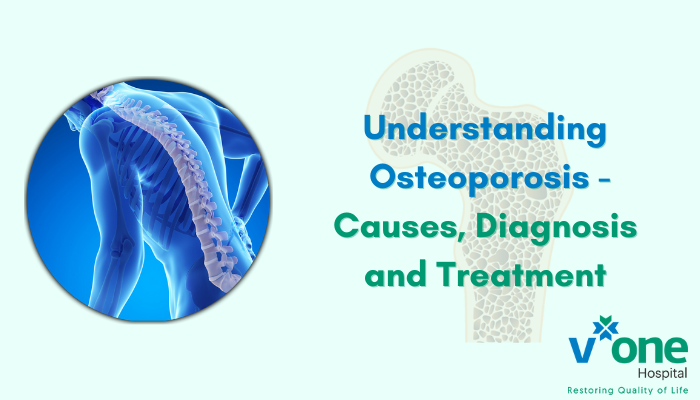Understanding and Managing Osteoporosis | Symptoms, Causes, and Treatment
About 20 crore people around the globe suffer from osteoporosis. Of all the fractures that happen every year, 20 lahks are because of osteoporosis.
What is Osteoporosis?
The bones in your body are living tissue that keeps being broken down and replaced. Old, damaged bone gets resorbed and new bone material gets deposited; this is called bone remodeling. But when the creation of new bone material can’t keep up with the loss of old bone, it could be a sign of osteoporosis.
The word “osteoporosis” means porous bone. Osteoporosis is a disease that makes your bones so weak and brittle that a fall or even so much as bending over or coughing can cause a fracture. It reduces your bone mass and strength, putting you at a greater risk for sudden and unexpected fractures. These fractures are usually in the hip, wrist, or spine.
Who gets Osteoporosis?
Although anyone can get osteoporosis, older women who have already reached menopause are at the highest risk.
Across the world, 21.2% of women and 6.3% of men over 50 suffer from osteoporosis. Women are four times more likely than men to get osteoporosis.
Symptoms: How to Tell if you Might have Osteoporosis?
Osteoporosis often develops without any pain or any other symptoms. This is why it is usually not discovered until it has already started causing painful fractures. It’s a silent disease.
But when symptoms do show, here’s what to look for:
- Have you gotten shorter by an inch or more?
- Have you developed a fracture?
- Has your posture drastically changed? Are you suddenly stooping or bending forward?
- Are you suddenly short of breath? (compressed discs can reduce lung capacity)
- Is your lower back hurting?
What causes Osteoporosis?
When you’re young, your body makes new bone faster than it breaks down old bone, and your bone mass increases. This process slows down after the early 20s and you reach your peak bone mass somewhere in your 30s. But then as you age, the amount of bone deposited with each cycle of remodeling also decreases. So, bone mass is lost faster than it’s created.
Your chances of developing osteoporosis also depend on how much bone mass you attained in your youth. A higher peak bone mass can mean that you are less likely to develop osteoporosis as you age. The peak bone mass can also be inherited and depend on your ethnicity.
Overall, you may be more likely to develop osteoporosis if:
- You are a woman
- You are aging and in your 50s
- You are white or Asian
- You have a smaller body frame
- Someone in your family has it too
- You have fewer sex hormones (this is also why when estrogen levels fall during menopause, bones can weaken)
- You have an overactive thyroid or you take too much thyroid hormone medication, leading to an excess
- You have overactive parathyroid and adrenal glands
- You don’t take in enough calcium
- You are underweight and don’t eat enough
- You have been taking steroids or certain other medicines for a long time
- You are a regular tobacco user
- You consume more than two alcoholic drinks every day
- You have a sedentary lifestyle
- You have cancer, Celiac disease, inflammatory bowel disease, rheumatoid arthritis, multiple myeloma, or kidney or liver disease
How is Osteoporosis Treated?
After receiving the diagnosis from a bone density test, you may be wondering about your options.
- Bisphosphonates: These antiresorptive drugs are the most commonly prescribed medicines for osteoporosis. They stop the body from reabsorbing bone tissue. Sometimes, they can cause side effects like nausea, abdominal pain, and heartburn-like symptoms.
- Denosumab: This is a human monoclonal antibody that inhibits RANKL and helps regulate turnover in healthy bone. Getting it as a shot under the skin every six months reduces the chances of cancer. It’s often used when other treatments have failed.
- Hormone-related therapy: Younger women and those needing to treat their menopause symptoms can benefit from estrogen therapy. Men with low testosterone can be prescribed testosterone. Raloxifene can also be helpful. The synthetic hormone calcitonin-salmon can reduce the chances of spine cancer.
- Bone-building medications: If you have severe osteoporosis or more common treatments haven’t been working, you can try one of these anabolic agents:
- Romosozumab: This is helpful for postmenopausal women who are at a high risk of fracture. It enables the new bone formation and decreases the breakdown of bone.
- Teriparatide: This drug is similar to the parathyroid hormone and it stimulates new bone growth. It’s given by daily injection under the skin for up to two years.
- Abaloparatide: Like teriparatide, this drug is also similar to the parathyroid hormone, and is taken for only two years.
Additionally, taking enough calcium and vitamin D and engaging in regular exercise can help keep your bones healthy.
If you are suffering from any kind of joint condition, consult the best orthopedic surgeon in Indore.

